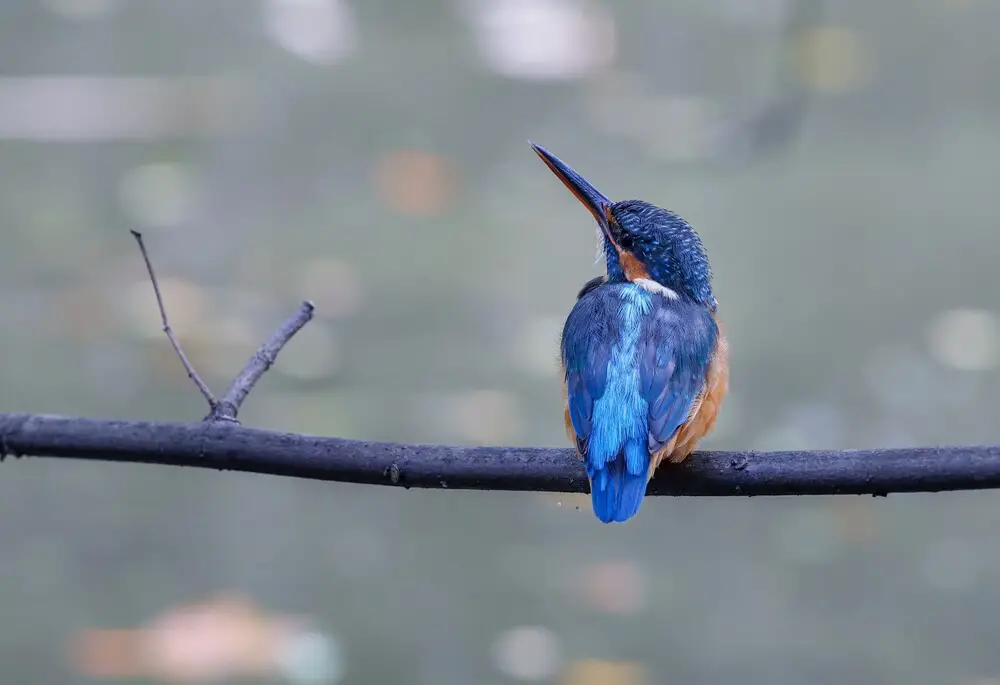
A kingfisher’s dive into water is beautiful, efficient, and graceful. They often have iridescent and beautifully colored feathers.
Found worldwide, these special birds have some unique facts that many may not be aware of.
Read on to learn more facts about the Kingfisher species.
1. Kingfishers Regurgitate Indigestible Food In Pellet Form

Since kingfishers swallow their prey whole, they regurgitate pellets of indigestible items. These include bones, teeth, fur, scales, shells, and more.
Interestingly, nestlings have stomach acid that breaks down the bones from food given to them by their parents. As they mature, the stomach acid is not as strong, so they produce pellets to get rid of the waste.
2. Kingfishers Have Unsanitary Nests
The kingfisher eats up to 60% of its body weight each day, consuming whole prey in their carnivorous diet.
As a result, they are producing frequent pellets to discharge the indigestible parts. This is often done in their nesting sites, which become littered with their droppings as well.
Nestlings often hatch into these unsanitary conditions with their parents.
3. Over 100 Species Of Kingfishers Are Found All Over The World
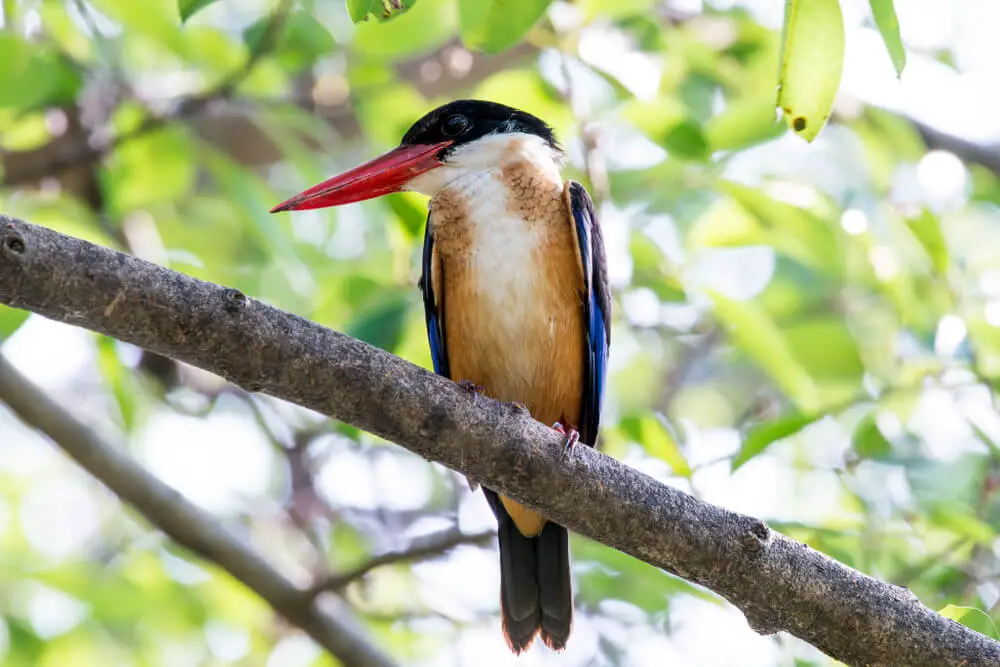
Kingfishers live on every continent except Antarctica. The majority of them are in Australia, Africa, and Asia.
Over 2 dozen of these species are considered at risk with a status of threatened, vulnerable, or endangered. The main threats to kingfishers are the degradation of habitats, food competition, and predation.
4. Three Species Of Kingfishers Live In The United States

Only 3 species of kingfishers are commonly found in the United States:
- Belted kingfisher: widespread, inland and coastal areas
- Green kingfisher: southern Arizona and Texas
- Ringed kingfisher: southern Texas
A fourth species, the Amazon kingfisher, may be seen in the American tropics. But, it is more common in southern Mexico, Central America, and Argentina.
5. Kingfisher Species Vary In Size
The largest kingfishers are the African giant kingfisher and Australian laughing kookaburra, which are up to 18 inches in length. However, the laughing kookaburra is the heaviest, weighing up to 1.11 pounds (17.76 ounces).
The smallest kingfisher is the African dwarf-kingfisher, at 4 inches long and ⅓ of an ounce.
In comparison, the Belted kingfisher common throughout the U.S. is 11 to 14 inches long and weighs up to 6.3 ounces.
6. They Are Categorized As Tree, River, Or Water Kingfishers
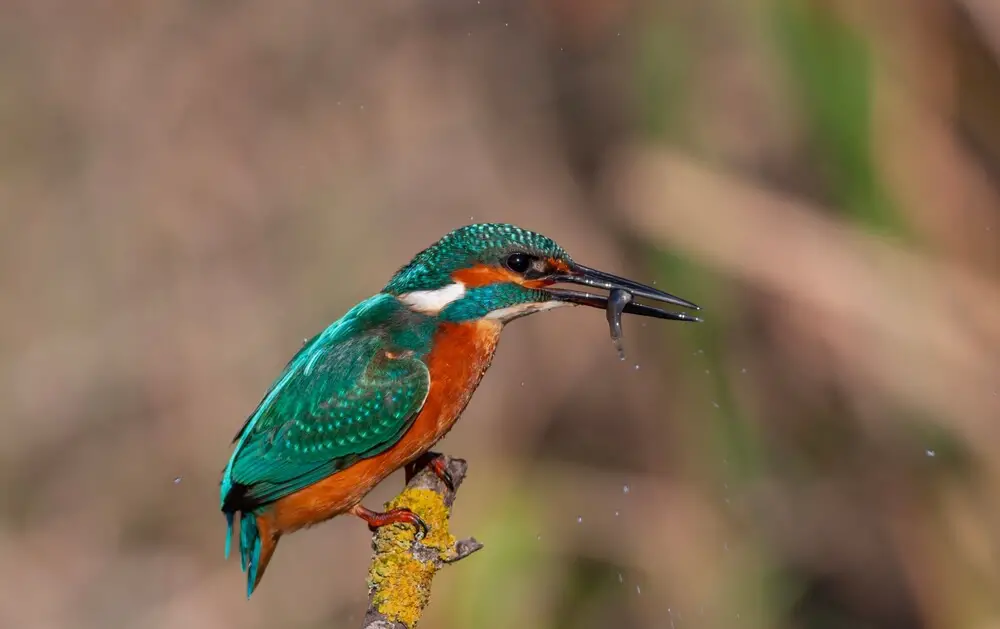
Kingfishers fall into 1 of 3 categories according to their habitat and diet.
Water kingfishers are found in North America, whereas river and tree types are in Europe, Asia, Africa, and Australia.
Tree Type
Kingfishers in this category rely less on water and eat creatures such as worms, insects, lizards, and small mammals. They nest in trees and are the most numerous type of kingfisher.
Examples are the forest kingfisher, kookaburra, and spotted wood kingfisher.
They belong to the Halcyonidae taxonomic subfamily.
River Type
These kingfishers eat fish, frogs, insects, tadpoles, spiders, flies, and other river-based creatures.
They tend to be smaller birds, and they perch and dive for food from river- and stream-side spots. They burrow near sources of food.
Examples are the Madagascar pygmy kingfisher, common kingfisher, and Syma.
They belong to the Alcedinidae taxonomic family.
Water Type
This type of kingfisher is piscivorous, feeding primarily on fish.
They nest in burrows near streams, shorelines, and ponds, and are often the biggest kingfishers.
Examples are all three U.S.-based birds: belted kingfisher, green kingfisher, and ringed kingfisher. Other examples are the pied kingfisher and giant kingfisher.
They belong to the Cerylidae taxonomic subfamily.
7. Not All Kingfishers Live Near Water

River and water kingfisher types live near water sources. These include freshwater rivers, streams, wetlands, and mixed fresh and saltwater coastal marshes. This is because they eat water-dwelling creatures, including fish.
Some kingfishers may also be seen near man-made water sources such as ponds, drainage ditches, and canals in urban and suburban areas.
Tree-type kingfishers, though, live in a range of habitats. These include tropical rainforests, thornbush areas, arid lands, and open woodlands.
8. They Are Seasonally Monogamous
Each year kingfishers pair up for breeding and to raise a brood of chicks. The male and female are monogamous during this season, but likely will find a new mate the following year.
They are both territorial once mated, defending the nest site from other kingfishers.
9. Kingfishers Are Cavity Nesters
Depending upon the type of kingfisher, they will nest in natural tree cavities or ground burrows. They may use abandoned termite mounds.
Males and females work together to dig ground burrow sites, often in sandy soil, using their front claws and bills. The burrows are only one tunnel, up to 15 feet long, with a round chamber for the nest.
This straight channel allows the kingfisher to direct its fast flight right to the nest.
10. Both Kingfisher Parents Care For The Offspring
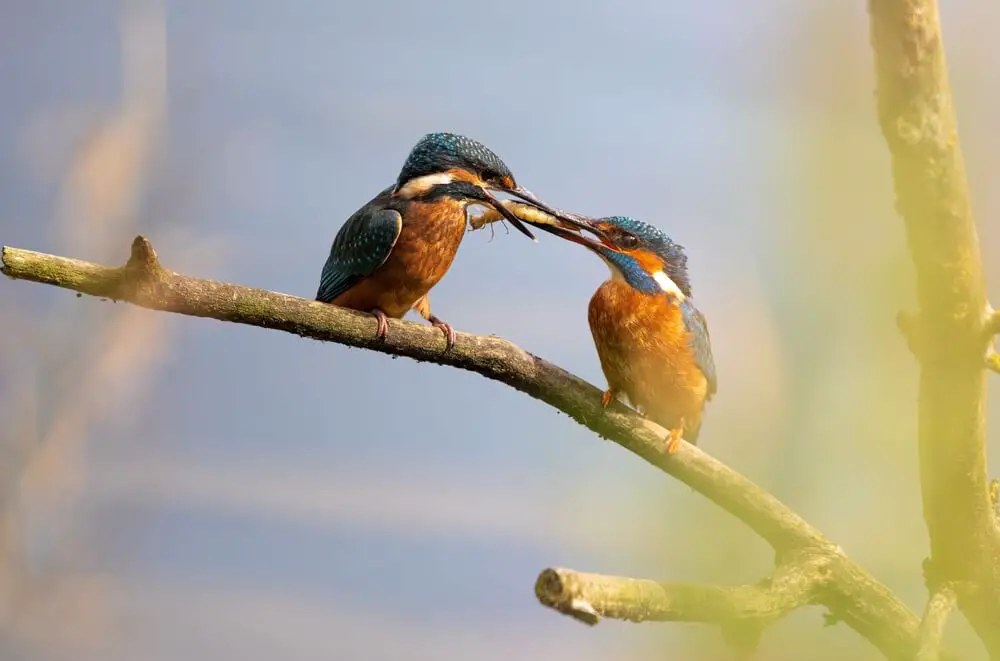
They not only work together to dig ground burrows, but kingfisher parents also both incubate eggs and care for the offspring.
Both parents feed hatchlings partially digested foods. The males typically offer food more frequently than the females.
The young leave the nest about 28 days after hatching but are continued to be fed by the parents for about 3 more weeks.
11. Cement Linings In Water Cause Issues For Kingfishers
While kingfishers can be found accessing man-made water sources, and adapting to the environment, this can pose some issues for them.
Channelization is when cement is overlaid in a riverbed or water source and foliage cannot grow. This takes away natural perches for the somewhat shy kingfisher.
Kingfishers also cannot burrow in the banks, fish start to die, and plants disappear. This negatively impacts their local habitat, breeding, and food sources.
12. Kingfishers Come In A Variety Of Dazzling Colors
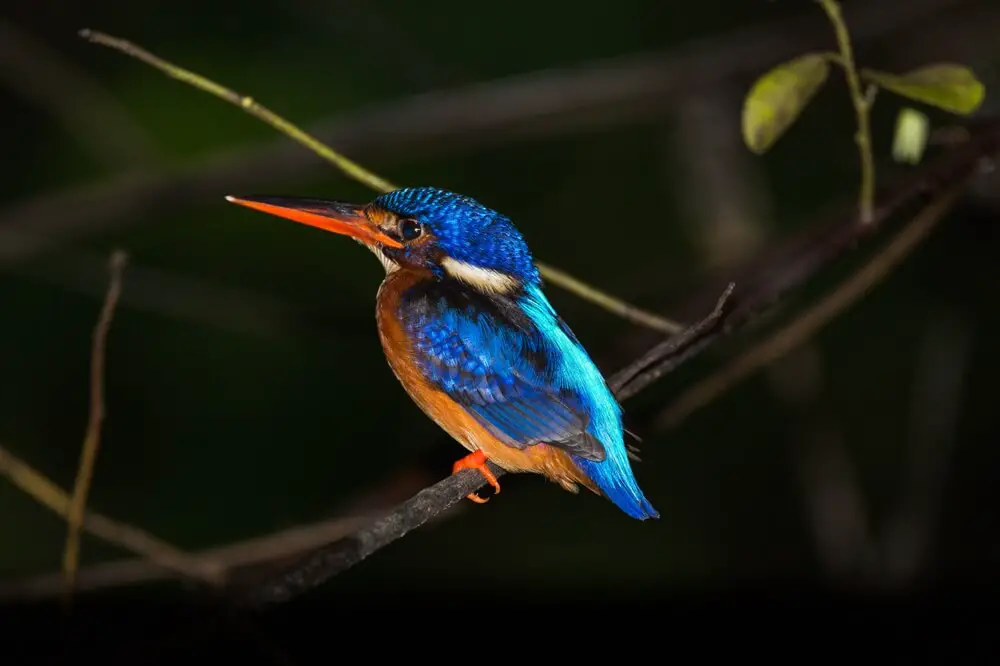
Many species of kingfishers have bright plumage with colors such as blue, teal, red, orange, yellow, green, pink, and purple.
They may also appear to have iridescence or metallic tones in their feathers.
Many species also have orange (or another bright) color of legs and bills.
13. Some Males And Female Kingfishers Look The Same

Some species of kingfishers are sexually dimorphic, meaning they look alike in coloration.
Even if they are not (dimorphic), they often look so similar it is still hard to tell them apart.
For example, the female belted kingfisher has a chestnut-copper band on her chest, whereas the male does not. Otherwise, they look the same.
14. Their Heads Are Built For Protection & Stabilization
The heads of kingfishers are disproportionate to their bodies. They have strongly developed musculature to protect their neck and brain as they dive at high speeds into the water for fish.
They also can keep their heads very still to stabilize their vision even if their perch or body is moving in the wind.
15. The Kingfisher’s Bill Is Hydrodynamic
The kingfisher’s bill is also large and disproportionate to the body.
It is a wedged, sword-shaped, pointed bill that cuts smoothly into the water to impale or snatch its prey.
16. They Are Predatory Hunters
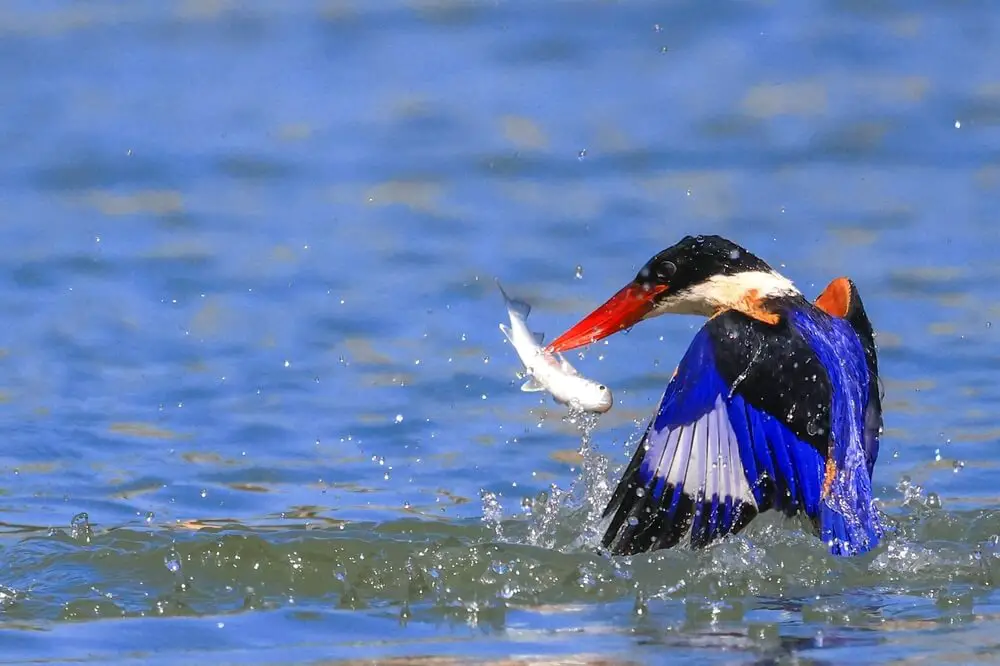
The kingfisher can dive up to 25 miles per hour, using its dagger-like bill and strong head to impale or grab prey.
They perch, wait, and watch from a branch over water or overlooking a large part of the ground.
It may eat the prey whole on the spot or bash it against a rock or limb to fully kill it. Bashing it also breaks up the prey’s bones to make it more easily swallowed.
Some species of kingfishers will also raid nests to eat nestlings and eggs.
This video shows a diving kingfisher in slow motion:
17. Kingfishers Fly Directly & Can Hover
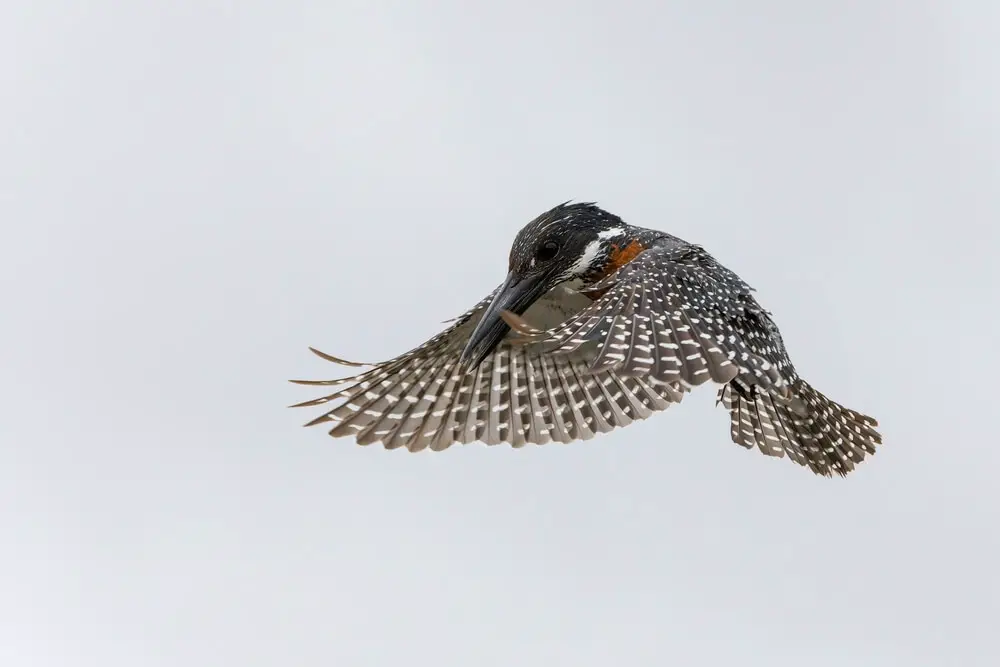
Kingfishers will survey, perch in the shadows, and wait for their prey, with a fast and direct flight path to catch it.
However, they can also hover and dive from a hovering position. Their ability to stabilize their head while hovering in the wind allows them to effectively catch food.
18. Kingfishers Are Most Active At Dawn & Dusk
Many creatures are active at dawn and dusk, including the prey of kingfishers. The cooler temperatures of dawn and dusk mean that creatures such as invertebrates, fish, and frogs are more active as well.
These are optimal times for hunting and getting a good meal.
19. Fledgling Kingfishers May Drown
Unfortunately, fledglings are clumsy as they first learn to dive for fish.
As a result, they can become waterlogged. As many as three-fourths of a brood may drown and never make it to adulthood.
20. Kingfishers Do Not Sing
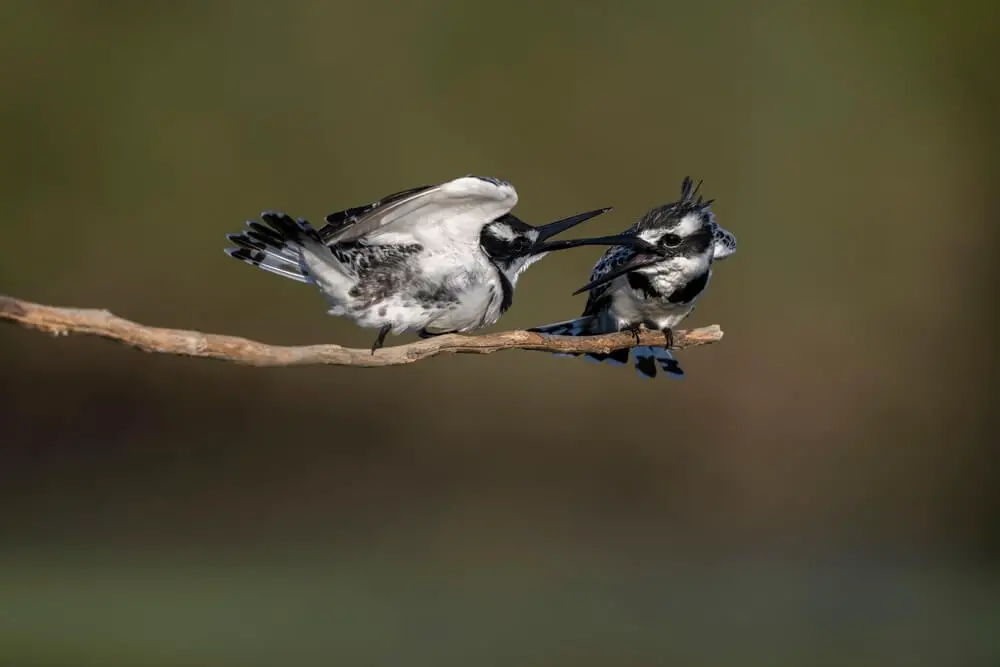
Kingfishers are not songbirds, even though many are beautifully feathered like those with songs.
Instead, they produce mechanical rattles, squeaks, screeches, cackles, or shrill whistles. These sounds are heard when they are disturbed or alarmed, to protect territories, and attract mates.
Conclusion
While the belted kingfisher species is widespread across the United States, kingfishers come in a variety of sizes and colors.
The kingfishers’ diving and stabilization abilities, nesting in burrows or cavities, regurgitated pellets, and more make them very unique birds to know about.

